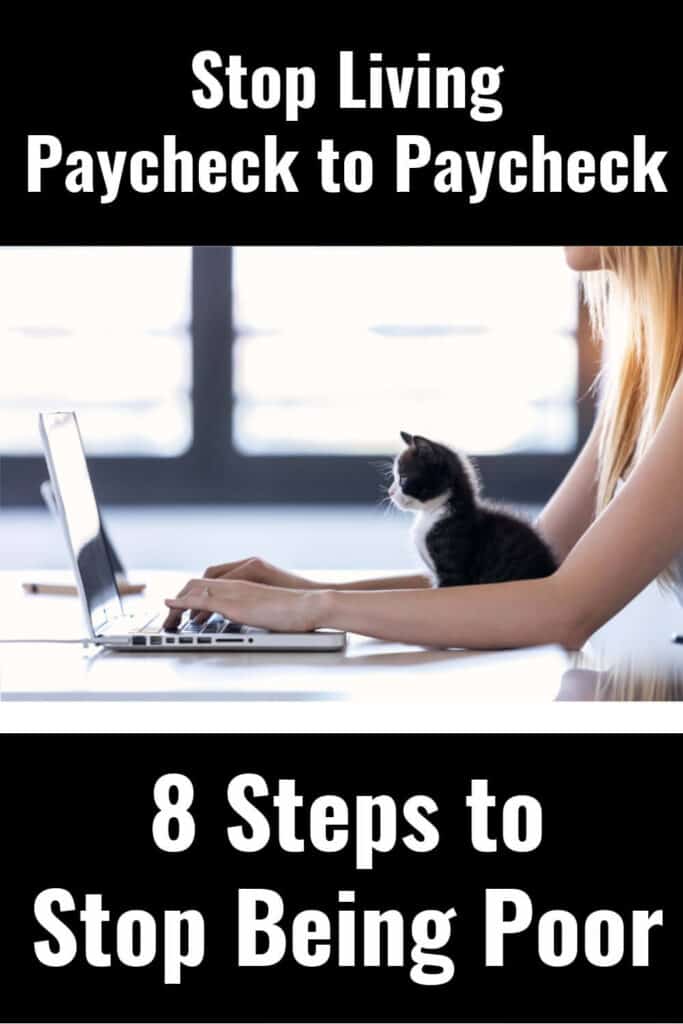“This post may contain affiliate links. Please read my disclosure for more info.
Most of us live paycheck to paycheck at some point in our life, but did you know almost 80% of us never stop living paycheck to paycheck?
If you’re never able to stop living paycheck to paycheck, how much choice do you really have to live the life you want?
It reminded me of the book, The Top 5 Regrets of the Dying, where Bronnie Ware interviewed dozens of people nearing the end of life.
The most mentioned regret was that people never lived the life they originally envisioned. They expressed a feeling of surrender, where they spent their entire life working to pay bills, answering to other people, never having the ability to pursue their dreams. And then time ran out.

Money may not create happiness, but it does create choice. Things like where we live, or our ability to travel, or train for a new career. Or to just go have a beer on the weekend.
But the key isn’t necessarily making more money. A recent study by Lending Tree found that 44% of millennials earning between $100,000 to $149,000 still live paycheck to paycheck.
So if you’re struggling trying to make ends meet now, stop waiting for that raise or promotion that never seems to come.
I’ve outlined some steps here that’ll help you to stop living paycheck to paycheck, get control over your money and take your future into your own hands.
Table of Contents
How to Stop Living Paycheck to Paycheck
Here are 8 steps that’ll help you to stop being poor and start seeing your net worth tick up a little bit each month. It’s not your next raise or bonus that’ll make a difference in your finances. It’s the small, 1% improvements that over time, will create more choice and less regret in your life.
1. Adopt the Right Mindset
If you’re living paycheck to paycheck now, it’ll help to accept the fact that it’s nobody’s responsibility to ensure that you get what you want in life. Depending on the government, or anyone else to help you survive financially is a stressful way to live.
And you don’t need to accept the idea that you’ll work jobs you hate and struggle to pay bills, while people around you take vacations and plan for the future.
Part of these steps will be to set periodic goals for yourself. Like paying off X amount of debt this year, or developing the skills for a better job. Goals will help to motivate you, but keep in mind, the real reason you’re doing this is to live your life with few regrets. To put yourself into position to do the things you want to do.
2. Start From Where You Are
The most basic truth about getting ahead financially is simple – spend less than you make. Part B of that would be to increase the gap between your income and your spending, then start investing some of that money into assets that appreciate.
But let’s not get ahead of ourselves.
Before you do can any of that, you need to know where you’re starting from. Because you can’t “live below your means” unless you know what your means is.
It’s easy to say, “just start using a budget” but most people don’t use one consistently. One reason people give up on budgeting is because unexpected expenses keep sabotaging it. We all have emergencies, but there’s also irregular expenses that may not be showstoppers, but still need to be paid. Together, they can make it almost impossible to manage your money.
I’ll go over two ways to make your budget predictable every month, so if you’ve given up on budgeting before, you’ll find it easier this time.
To start your budget, just look at the last full month, and create categories for everything you spend money on. The focus here is just to document expenses and see an accurate picture of where your money goes each month. And to have a way to do it again next month to compare.
Here are 10 different budget templates you can download for free, that’ll give you a head start.
Think of your budget, not as something to restrict you, but as a tool that’ll give you answers on how to move forward. Also, consider that it’s a work in progress. It’s normal to spend the better part of a year tweaking expenses and evaluating your needs and wants. But it’s worth it.
Action Step:
Create a budget that includes categories for everything you spend money on in a typical month. Record the expenses for your last full month and see how the total compares to your income.
One of these 10 printable budget templates can help.
3. Establish Regular Money Meetings

You can stop living paycheck to paycheck, but an important thing to realize is that you don’t need to be a money expert to do it. Getting control of your money is more about developing consistent habits.
Sure, living within your means is key, but that’s just part of it. Our aim is to stop living paycheck to paycheck, then get to a point where you can start building wealth.
So whether you’re single or have a partner, sitting down once a week and checking on your progress is a big key. It’ll feel a bit awkward first, but once you develop a routine, your money meetings will be easier. And when you start to see progress, they’ll be motivating.
What should you review in a weekly money meeting?
- What’s your number one priority for the next year or so? Paying off debt, saving for a new home, building emergency savings or a side business? Keeping it in focus can help a lot of smaller spending decisions fall into place.
- Compare your budget to your checking account and see if your spending is going as planned.
- What’s coming up in the next few weeks that you might need to plan for?
- Think about your lifestyle. Is there anything you could adjust that might help you to reach your number one goal?
- Or maybe you’ve made some progress and deserve a little celebration.
And once a month, you may want to consider some longer term issues:
- The best way to see the trajectory of your financial health is to check your net worth. If it went up or down over the past month, you’ll probably know why. Did you pay down debt, or increase savings? Your net worth is easy to see with apps like Personal Capital, and it’s a great motivator to see that your efforts are actually working.
- Consider your career, and how you earn money. Are you doing what you want to do? If there’s something you’d rather do, what can you do now – even a small step – to start moving in that direction?
Taking 20-30 minutes for these regular money meetings may seem like a chore at first, but it does get better as you feel more control in your life.
It’s like beginning a health or fitness habit. It’s tough initially, but as you feel the results, you begin to adopt the mindset of a healthy person. Then maybe you’ll enjoy a night out with pizza and beer, but the other 90% of the time, you’re eating healthy.
Related: Personal Capital Review – The Free App to View All Your Accounts in One Window
4. Protect Yourself (and Your Budget) from Emergencies
Once you’ve created a budget and you can compare your income to your expenses, you’ve got a starting point. Even if it seems hopeless, you can make progress.
Here’s where we start making small changes, that together, will help you to create a gap between what you make and what you spend.
We’ll address individual expenses, but the first step might surprise you if you’re struggling to pay bills right now.
First, if you don’t have an emergency fund, you need to start one immediately.
It might seem counter productive to add another “bill” to your monthly expenses, but not having cash to pay for emergencies is one of the main traps that’ll keep you in paycheck to paycheck life. You can spend hours creating the perfect budget, but when your car needs a $900 repair, using budgeted money or putting it on a credit card will put you right back to square one.
The two keys to an emergency fund are:
- It needs to be in a separate account from your checking account. Trying to keep a buffer in your checking account doesn’t work.
- There needs to be a regular (preferably automated) deposit into it.
It’s a gradual climb out of paycheck to paycheck life, and depending on where you start from, it could take a year before you begin to feel in control. During that time, we all experience emergencies, so your ability to pay cash for them helps to maintain a predictable budget and stop adding to your debt.
This is a key step in moving from a short-term, paycheck to paycheck lifestyle, to longer term thinking and getting into position to save.
Action Step:
Open an account for emergencies. Automate a regular deposit into it and aim initially to get $1000 in it. This should cover most emergencies, and when one occurs, your automated deposit will gradually replenish it.
Here’s how we set up an automated emergency account.
5. Put Yourself Into Position to Eliminate Debt
If you’re living paycheck to paycheck, chances are, debt is a problem for you. Whether it’s a car loan, furniture, student loan or credit cards, the result is the same. It’ll take years to eliminate debt if you’re making minimum payments.
For example, a credit card balance of $5000 might have an interest rate of about 21%. Making minimum payments each month would take over 30 years, and over $21,000 in finance charges before it’s paid off.
Living with debt means you can’t afford to do much in life, but the worst part is the opportunity cost. When your income is tied up in servicing debt for years, you’re not able to save and invest.
This step is about positioning yourself to start eliminating debt.
Since you’ve already created a budget, you’re now able to see where your money is going each month. Now you can examine each expense, and decide what can be reduced, adjusted or eliminated, and apply the money saved toward debt reduction.
Here are a few examples we found when I created a budget:
- Food spending can be a quick win. Our budget showed we were spending almost $1000 a month on food for myself and two kids. With a little planning, we were able to save several hundred dollars a month. Here’s how we were able to drastically reduce food costs.
- Do you still have cable TV? Cable is an antiquated business model from the1980’s where you pay for dozens of channels you’ll never watch to get the few you do watch. Here are 20 cable TV alternatives that’ll save you money each month.
- Insurance policies are usually auto-deducted from your account which makes it easy, but it’s also a way for those costs to fly under the radar for years. Chances are, you’re paying hundreds of dollars a year more than you need to.
- Check with a neutral site like Policy Genius where they’ll get you free quotes from several companies without ever calling you on the phone. It’s all through email, and for 30 minutes of time, you might save hundreds of dollars. We did, and after years of bundling my home and auto policies with Allstate, I saved over $2000 per year by switching to another company.
- Are you paying for a new car? Even with a very low interest rate, a car depreciates so fast that’s it’s hard to even call it an asset. What if you could eliminate that payment and apply the money to eliminating debt or even investing it. This post, How to Save $10,000 in a Year includes a way to buy a decent car without tying up money in monthly payments.
- This may be a tough one to face, but consider your living situation. Are you in a home that’s costing so much that it’s difficult to afford basic necessities? This is a personal decision, but if you’re struggling financially, downsizing for a few years can help you to stop living paycheck to paycheck and begin to build savings.
As you go through your budget, you may also find some black holes where your money seems to disappear. We all want a life outside of work, but if you’re on a mission to get control of your finances, it’s an opportunity to look for cheaper ways to have a good time.
To reduce debt quickly, try looking around your house for things to sell. Treadmills or other sports equipment, tools, or furniture can all bring quick cash. You can even sell your clothes online.
Related:
Action Step:
The idea of this step is to go through each expense one by one, not to cut every joy out of your life, but to evaluate needs vs wants. Some things may have made sense at one time, but right now could be extra weight holding you back.
And for the expenses you keep, we’re trying to get equivalent value for less money. Like pruning a plant, this step is about cutting back the excess in order to grow stronger.
6. Consider Bringing in More Income

2020 has shown us that employment isn’t as secure as it might seem. But even without a global pandemic, businesses are increasingly looking to reduce costs.
Businesses almost always train multiple people for the same job to protect themselves. We should also protect ourselves and have more than one source of income.
If you have debt to eliminate, life is passing you by while you’re making minimum payments. Even an extra $400-$500 a month can really accelerate your progress, and put you in a position to start saving and investing quicker.
There are now dozens of ways to make extra money without having to punch a clock and work in the shadow of a manager all day.
Here are two articles that feature lots of ways to earn more income:
Most of the side hustles in the posts above are things you can start right away, without spending lots of money. In fact, many people begin a side hustle and find that they’re more passionate about that than their regular job, and end up turning it into a full-time job.
Let’s face it, to stop living paycheck to paycheck probably requires a few lifestyle changes during the next year or two. You may not want to work a side hustle forever, but if you’ve been living paycheck to paycheck for awhile, things aren’t likely to change unless you make some changes.
Action Step:
If you’ve got significant debt that’s preventing you from building savings, a side hustle from one of the posts above can accelerate your progress.
7. The Second Key to Making Your Budget Predictable - Sinking Funds
Creating a budget to monitor spending, and an emergency fund to help control debt are two huge steps to ending paycheck to paycheck life. But there’s another simple piece you may want to add that’ll help with two other scenarios:
- Irregular costs like a quarterly water bill, a birthday gift, a child’s sports team registration or school expense. They’re not emergencies, but they still interfere with your budget.
- Or things you want to buy. Eliminating debt is great, but what if there’s something you want for the house, or maybe you’d like to plan a weekend trip. Or maybe your car will need to be replaced within the next year or two.
This is what sinking funds are for. Irregular expenses that aren’t emergencies, but still need to be paid, or things you want to buy without adding to your debt.
Sinking funds are easy to setup. And since a big key to budgeting is making it predictable, sinking funds will make your life easier.
Here’s how you can setup sinking funds.
8. Begin Saving and Investing
Each of the steps before this were building the foundation to get to this point.
- First, a budget enables you to consistently track and manage income and expenses.
- An emergency fund and sinking funds help to keep your budget predictable.
- We setup systems to eliminate debt in order to create a gap between what you earn and what you spend. We also found ways to increase income to accelerate the whole process.
The idea was to get to this point as quickly as possible. Because, a little tough love here – if it takes two decades to stop living paycheck to paycheck, then you’ve sacrificed the most powerful ingredient in building a secure retirement – time.
If you can start saving early enough and let the magic of compound interest work, it’ll make a huge difference in the quality of your life later. The key is getting to this point.
Action Step:
Begin an automated savings program as soon as possible. Have a consistent amount taken off the top of whatever your earn, deposited into a 401k or Roth account.
If your employer sponsors a savings program, that’s a great place to start because they likely kick in a percentage of whatever you contribute. Absolutely contribute at least enough to get their maximum match. Even if you start with 3-4% of your salary, you can gradually increase your contribution as you eliminate debt, or get a raise or a bonus.
Try to work your way up to about 15% of your salary, but remember, your employer will be kicking in some of that.
One milestone to shoot for, is to save your first $100,000. Because once you do, it’ll take less time to reach $200,000, and even less time to reach each successive milestone because compound interest is now working for you.
You Can Decide to Stop Living Paycheck to Paycheck
The most important point to take from this, is that you can stop living paycheck to paycheck without waiting for a raise, a promotion or some other windfall to happen. It’s much more dependent on our own habits.
James Clear used an example in his book, Atomic Habits, of an airplane taking off from Los Angeles, destined for New York City. If the pilot put the wrong coordinates into the auto-pilot and was off by just 3.5 degrees, he’d arrive in Washington, D.C., hundreds of miles off course.
Seemingly small changes, adjust our trajectory just enough so that over time, they have an enormous affect on our long-term outcome.
It might seem futile going through your expenses and canceling cable, reducing your grocery spending by $150 a month, or paying off your credit cards. But together they all contribute to your ability to create a gap between what you earn and what you spend.
Once you can do that, and begin to save and invest, your choices in life begin to expand. And isn’t that what we all want from life? The ability to choose our path?

